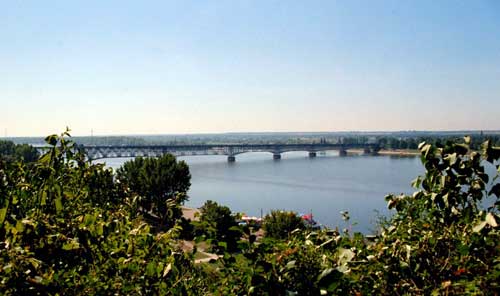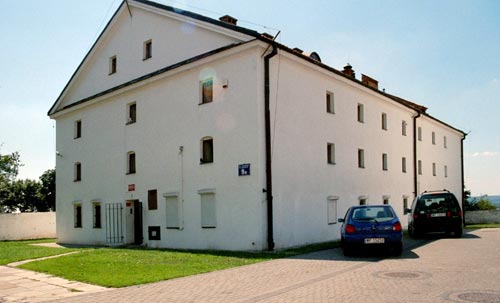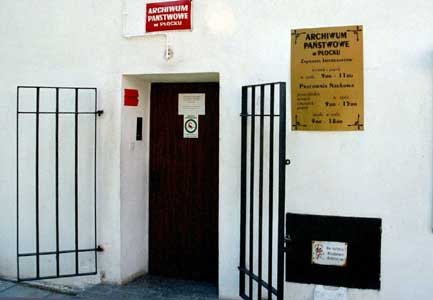 |
 |

|
Fifty Church Booksor: A Visit to the Płock Archivesby Jutta Dennerlein |
|
Jutta Dennerlein lives near Munich, Germany. Her mother's ancestors seem to have always lived near the Vistula, so also in the Płock area. Genealogical enthusiasm sometimes leads her to quick decisions … |
|
Get document Fifty Church Books - Size 150 KB |
|
In 2003 I went again to Poland. Some "new" places, that had evolved from family research within the last years had to be visited, new information that the old aunts happened to remember had to be checked on site and after all: the last visit to Poland had been two years ago! But the deciding factor for the very spontaneous idea to drive to Poland alone had been Magda's mail, announcing that she would drive over from Lublin to pay a visit to the Płock Archive before it's closing time in august. So why think twice? It was already mid of July! The nice hotel near the Vistula was already overbooked. But the Petropol confirmed my booking by e-mail. So one week later I sat in my car and started for Płock. I had planed two days for the journey, 1100 km from Munich to Płock seemed to be quite a long distance for driving alone. But the hotels along the truck driver route between Frankfut/Oder and Poznan didn't look encouraging to me and they all seemed to offer additional services, that I had no need for. So I kept on driving and it was much nicer to stay in the air conditioned car than at a loud roadside hotel suffering 30°C. But after passing Gostynin, when the road ran straight to the Vistula I was glad that soon there would only be the Vistula bridge left between me and Płock. O.k., I could not foresee, that the bridge was closed and that I had to wait another two hours along with all the other weekend trippers before I could cross the bridge. But finally even this obstacle had been mastered and I was looking forward to a shower and an additionally gained day at Płock.
Vistula bridge at Płock - Photo by Jutta Dennerlein, 2003 I don't want to go too much into details about the new impressions I could collect during my extensive excursions in the Płock area and in the city and how much it becomes second nature to look out for signs of old overgrown cemeteries. This will have to wait for some other report. But I want to mention a small incident, that impressed me quite a bit. Somewhere on my way I had stopped at a gas station and when I reversed my car to drive away, something that had looked to me like a plastic band that came out of the concrete of the parking lot turned out to be a steel band and it tore away half of my front spoiler. I could not go any further with those parts hanging down and did not know what to do. Suddenly some guy who had observed my mishap and who didn't understand a word I was saying, came over with his tool box in hand and simply started to repair my car. I was stunned! He worked over an hour in the hot sun. But finally, with the help of some simple screws and some "additional parts" that he found in the garbage dump of the gas station, he managed to fasten everything without any repair to be seen. The spoiler still holds today. I only wished I could have thanked my friend in need in a language he could have understood. But the highlight of this trip to Poland should be the visit to the Płock archive. For this the last two days of my time at Płock were reserved and this is what this report is about. My Polish internet acquaintance had planed to come over on Thursday – the day when the Płock archive opens long hours. On Wednesday she sent me an e-mail telling me, she could not make it before Friday. So nobody there to help with the registration or other situations where Polish would be needed! So what – I would just go there and find out how far I could get with English or German. The Płock archive is located in one of the former granaries above the Vistula bank.
State Archive at Płock - Photo by Jutta Dennerlein, 2003 The address is: Archiwum Państwowe w Płocku, The street name had been changed within the last years (has been ul. Wieczorka 13) – so it is hard to find if you don't use a newer city map. The archive has it's own webpage with an English version. I used this page for the preparation of my trip and I also used the Pradziad database to check the holdings of the archive. If you want to visit the archive it is not really necessary to have an appointment. But it might be a good idea to check with the archive that they are really open and that someone speaking English will be around.
Entrance to the archive - Photo by Jutta Dennerlein, 2003 I was lucky because when I came to the archive there was somebody available who spoke English. All the people from the archive that I met seemed to be very competent and cooperative. The archive has a small reading room where you have to register with the usual formalities when visiting an archive. You have to fill in a form stating the reasons and intentions of your research. In 2003 this form has been only available in Polish. But I was lucky again: a Polish researcher who was using the reading room and spoke German helped me to fill in the form. Then I had access to the archive's materials. I had planed to concentrate on Church Records. The years between 1890 and 1900 of the Płock Church book have not been filmed by the LDS. So I wanted to start with them. The two years that I had ordered seemed to be not worth the way to the store room. So the friendly archivist asked me if I would need more of the newer or more of the older Church Books. I answered "more of the older ones" and the archivist disappeared for a while. When she came back, she wheeled a cart carrying all (!) the Church Books between 1845 and 1895. Fifty Church Books! All originals. All fully available at the same time. And all for me! You have to be devoted to family research to imagine what this means! The Płock and Gabin Church Books that I saw during this visit all have been in a rather good condition. Fortunately even the mistake of having the books newly bound has been avoided. Each book contains a loose sheet where each usage has to be documented and confirmed by signature of the user. If necessary the supervisor at the reading room can arrange copies. It is really great to work with the original Church Books and it is moving to see in some cases the original signature of your ancestors. But there is also a great disadvantage: Each of the ancient books left small particles of paper and leather on my desk – mostly parts of the binding – but still … So for me one of the results of this impressing visit to the Płock archive is the decision to never touch an original Church Book if there is a Microfilm or other reproduction available. After two days of intensive and rewarding research in the Płock archive I could start my journey home – loaded with a whole bunch of new and positive impressions and certainly not for the last time. |


